After 57 years of precipitation, Wal-Mart has the purest new retail genes, and investors’ thinking about investing in Wal-Mart has also transformed from a traditional retail company to an Internet company. Can Wal-Mart’s games in the past few years be successfully realized in the future?
Wen / Futu Research
Author / eva
In July 2017, Alibaba’s Hema Xiansheng opened the door to new Chinese retail for Chinese consumers, and fully deployed offline stores in key cities in an effort to achieve 30-minute home delivery and provide high-quality and cheap retail. service. As everyone knows, in the United States on the other side of the ocean, a world-class company has already accumulated the purest new retail genes through 57 years of sedimentation: low price, complete goods, and convenience. In 2015, the world’s largest retailer Wal-Mart, under the leadership of CEO Dong Minglun, began a revolutionary road to e-commerce. Will this road eventually build a century bridge that connects traditional heavy-asset companies with Internet companies?
The collapse of business myths
Wal-Mart was founded by Sam Walton in 1962. Starting from a small discount store in Arkansas, it has been adhering to the mission of “saving customers and making their lives better” for the past 50 years Is the world’s largest retail company.
At present, the company’s main business is divided into three major sections: American Wal-Mart (65.06%), International Wal-Mart (22.78%), Sam’s Member Store (11.38%), has more than 2.2 million employees, and has a presence in 27 countries. 11,000 stores, established its own transportation system and satellite system. In terms of turnover, Wal-Mart has ranked No. 1 in the “Fortune 500” list selected by Fortune Magazine for six consecutive years.
“Respecting every employee” and “Don’t drag today’s things into tomorrow” are people who have become aware of Wal-Mart’s corporate culture and have become a success story for modern enterprises. However, with the popularity of mobile Internet in 2012, Amazon stood out in the US market. From 2010 to 2018, the US e-commerce turnover increased from 133.5 billion to 568.8 billion US dollars, with a compound annual growth rate of 16.21%; compared to the 2.9% compound annual growth rate of the U.S. supermarket industry during the same period, this figure is far lower than that of e-commerce Growth rate. According to the adjusted stock price comparison, Amazon’s stock price has left Wal-Mart far behind, and Wal-Mart has been “surpassed.”
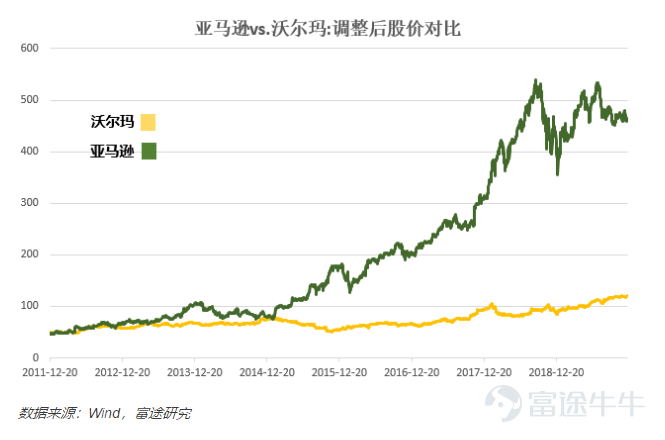
The growth rate of the company’s total operating revenue has begun to decline since 2012. On January 31, 2014, the company’s financialThe latest data from the newspaper showed that Wal-Mart’s development prospects “disappeared.” In FY2014, the total revenue growth rate fell sharply by 3.40% to 1.60% year-on-year; Sam’s member store revenue growth rate fell 3.80% to 0.30% year-on-year; Wal-Mart’s US market revenue fell 0.50% year-on-year; First decline. In 2014, Wal-Mart’s stock price fell back to its value 4 years ago in a year. That year, people thought that even a big man like Wal-Mart could not withstand the destruction of Internet e-commerce, and the hegemony of the retail empire seemed to be shaky.
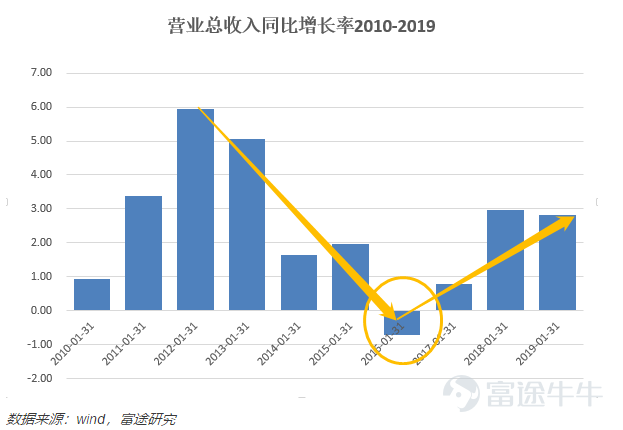
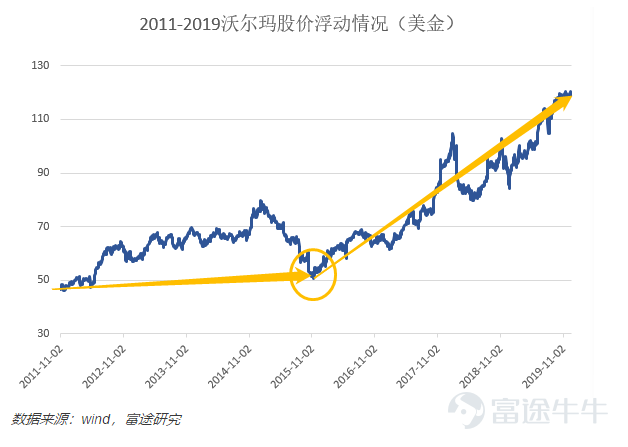
Combined with the above table, we can see that at the end of 2015, the company reversed its decline to rise, forming a significant historical turning point.
In 2015, the company ’s board of directors changed dramatically. Robert Walton, the son of Sam Walton, announced that Regory Penner would take over the chairmanship of his board of directors and become the company ’s youngest board chairman. On the other side, a grass-roots employee who started from Wal-Mart’s summer hours worked, and in a short period of 30 years, became the youngest CEO (CEO) of Wal-Mart. His name is: Dong Minglun. The two young leaders hope to transform Wal-Mart into an Internet company, or an omni-channel retail company; they hope that the company can continue to innovate rapidly, adjust quickly after failure, and seize the opportunity when the new era is approaching.
In the next 3 years, members of the board of directors and company executives have continuously changed, replacing the traditional traditional retail thinking with a new generation of omnichannel retail thinking.

The turning point in history: Dong Minglun makes dreamsInto the reality
Dong Minglun started at the grassroots level. He understood all aspects of Wal-Mart. Reggie Penner has served as Chairman of the Technology and Electronics Committee of Wal-Mart’s Board of Directors and an analyst at Goldman Sachs, where he has a deep understanding and track of market dynamics. Joining forces to choose the most important trend for Wal-Mart: e-commerce. Dong Minglun and Reggie Penner know that e-commerce is the key for Wal-Mart to open up global channels. Wal-Mart, which “eats the mountains and eats the mountains,” will one day be surpassed. As the youngest CEO since the founding of Wal-Mart, Dong Minglun has decided to start a new round of innovation and transformation. In the year he took office, Dong Minglun informed investors: “We are building an Internet company among the world’s largest retail companies.”

For a company as large as Wal-Mart, it’s not enough for the reform to take place in a small headquarters. The reform needs to be truly implemented in every waiter who welcomes customers offline, whether they are willing to give up the traditional retail ideas they are familiar with and embrace the ever-changing Internet. Therefore, just putting on the outer cover of a technology company cannot drive a high-asset company with 11,438 stores to make rapid changes. In order to increase the speed of Wal-Mart’s transformation and thoroughly blend traditional enterprises and the Internet, Wal-Mart must completely change its blood.
Dating back to the path of e-commerce transformation from 2015 to 2019, Dong Minglun, who has become the CEO step by step from the bottom employees, emphasized three things:
· Support and encourage Wal-Mart salespeople;
· Use innovation and technology to upgrade in-store management and delivery speed;
· Rapidly expand the global market and acquire leading companies.
Employee layout
In January 2015, Wal-Mart announced that it spent 2.7 billion U.S. dollars to raise minimum hourly wages, implement new employee training programs, and give employees more job control. Wal-Mart employees received more authorization and incentives. Inventory management will be effective; in December 2016, it announced the establishment of 200 employee training bases in the United States.
Innovative layout
In October 2015, Wal-Mart plans to invest 1.1 billion U.S. dollars in the research and development and improvement of online retail websites and shopping APP technology; in 2016, it proposed to establish a “Catering Innovation Center” to continuously deliver high-end new food to Wal-Mart and Sam; At the end of JuneWalmartPay has landed in all its stores, and provides online shoppers with two days of free low-cost free delivery to enhance online product categories. In July 2017, the technology incubator Store N ° 8 project was launched, focusing on retail transformation and Future retail development; In February 2018, the company was renamed from Wal-Mart Stores to Walmart to reflect changes in customer shopping methods and integrate online, online and mobile shopping methods; December 2019 , Announced that it has partnered with Nuro to develop a self-driving car delivery service that covers the last mile at low cost.
Global layout
In July 2015, the company announced the purchase of 100% of Yihaodian for US $ 760 million. In June 2016, it established a strategic partnership with China’s largest online retail company, JD.com, holding a 10% stake in JD.com; 2016 In September, it acquired jet.com, a leading U.S. e-commerce company for $ 3.3 billion, and acquired five U.S. leading e-commerce apparel stores in 2017.In 2018, it acquired Flipkart, India’s largest e-commerce company, for $ 16 billion, becoming a global Walmart The core of the e-commerce plan is to enter the Indian market.
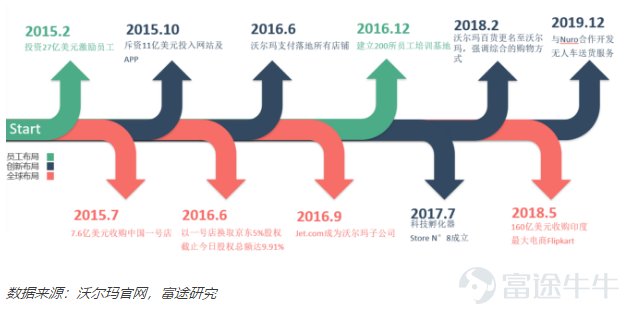
Dong Minglun took full advantage of the company ’s huge cash reserves, ignited large sums of money, and quickly united the target to build a new retail network in Wal-Mart’s dream worldwide. Dong Minglun’s efforts have been effective: Wal-Mart’s e-commerce revenue grew from the first quarter to the third quarter of 2019, with an average sales growth rate of 38%; during the same period, Wal-Mart accounted for 4.6% of the total US online retail sales of US $ 525.7 billion Amazon (47%) and eBay (6.1%) are the third largest retailers in the U.S. and seventh in the world. Combining the third quarter 2019 financial report data and eMarketer data, we can see that Wal-Mart has shown a rapid rise in e-commerce business. But compared to its huge offline revenue and investment, Wal-Mart’s online retail is still sharpened.
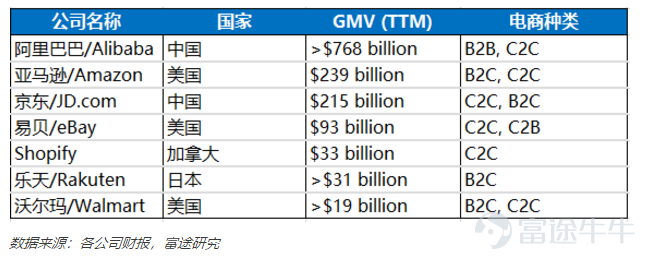
After the last round of analysis, we saw that Wal-Mart was determined to pecking its beak and breaking its claws in 2015-2019, closing its loss-making stores, and upgrading it to become an online-to-offline compound enterprise. Although Wal-Mart has ended the pre-arrangement of new retail, the gap between retail sales of offline business and online business is still huge, and it cannot bring excess returns to the company. Next, what should Wal-Mart do?
Wal-Mart’s Future: Offline + Online Retail War Begins
A few days ago, Wal-Mart’s e-commerce business layout has basically formed, and the gap with Amazon’s online business is gradually narrowing. The competition between the two retail giants has been officially put on the table. The competitive battlefields are spread all over the world. The three most important battlefields are: 1) the basic market of Wal-Mart and Amazon: the US market; 2) the sad ground of Wal-Mart and Amazon: the Chinese market; 3) the new battlefield of Wal-Mart and Amazon: the Indian market .
Key battlefield analysis:
According to Wal-Mart’s 2019 annual report and 2019Q3 quarterly report, Wal-Mart in the United States is the core basic disk. The proportion of Wal-Mart in the main composition of the United States has gradually increased from 58.51% in 2013 to 64.48% in 2019. The latest international Wal-Mart has shrunk by more than 5% compared to its 2013 data. The main reason is that major international markets such as Central America, South America, and the United Kingdom are basically full, while Asian markets such as China and India have not made much progress. Despite the rapid development of China’s retail industry, Wal-Mart is fiercely competing with major e-commerce and local supermarkets. It has been in the reshuffle phase in the past five years and is expected to begin to exert its strength in the next 1-3 years. The Indian market is in the midst of burying seeds In the stage, the acquisition of India’s first e-commerce platform is expected to start in 3-5 years.
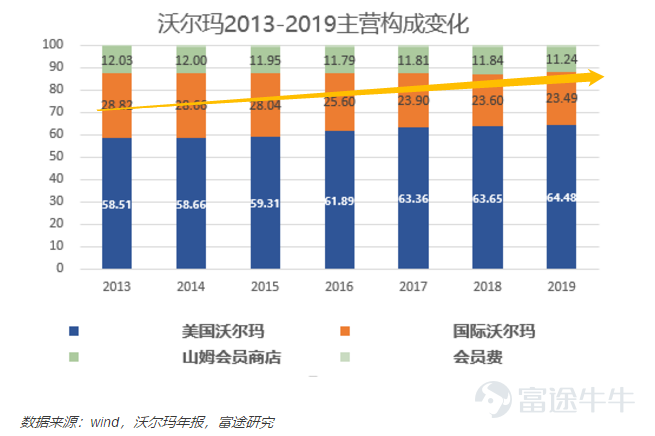
Summary: In terms of market share: US market> China market> India market, in terms of market prospects: India market> China market> US market.
U.S. Market: Sword and Blade
The US retail industry magazine “Stores” ranked the “Top 100 US Retailers” of 2019 in terms of total U.S. retail sales in fiscal year 2018, showing that Wal-Mart surpassed second place Amazon with an additional advantage of 26.693 billion US dollars, ranking first in the list; Amazon quickly climbed 6 places in two years and won the second place. The rapid growth rate has become a very destructive dark horse in the retail industry. In June 2017, Amazon started with 137The acquisition of Whole Foods at a price of 100 million US dollars, officially entered offline retailers in the United States, and sounded the alarm bell of Wal-Mart and Amazon online + offline battlefield.
Compared with only 490 stores owned by Amazon’s Whole Foods, Wal-Mart has 5,263 stores in the United States; Comprehensive Whole Foods is more focused on urban residents and high-spending people, and Wal-Mart’s offline retail stores basically guarantee 20 minutes for each community Within a drive, there is a Wal-Mart, covering a wide range of people. The data below shows that in recent years, the demand for online shopping by American residents has been increasing. Between 2018 and 2019, more than 20% of people chose to buy supermarket supplies online. The online retail model will further penetrate small urban residents in the Midwest, Mideast, and South of the United States. The proportion of US netizens choosing Wal-Mart nearly doubled compared to 2018. According to Wal-Mart’s 2019Q3 financial report data, e-commerce increased sales by 1.7% compared to single-store sales in March, and online sales increased by 41%. On December 11, 2019, Wal-Mart officially announced the opening of a self-driving car delivery service and will officially operate in Houston next year. This advancement has greatly improved the efficiency of Wal-Mart’s delivery services and will serve millions of customers.
In July 2018, Walmart partnered with Microsoft to use Microsoft’s cloud services and artificial intelligence (AI) technology to provide consumers with an easy and advanced shopping experience. In November 2018, Sam’s Club announced the launch of unmanned convenience stores. To compete with Amazon Go; by the end of 2019, Wal-Mart will have approximately 3,100 pickup points and 1,600 stores supporting delivery services, and the speed is still increasing. Based on the advantages of Wal-Mart’s physical stores in the United States and the precipitation of US Internet users’ consumption habits, Wal-Mart’s online retail business will usher in an explosion.
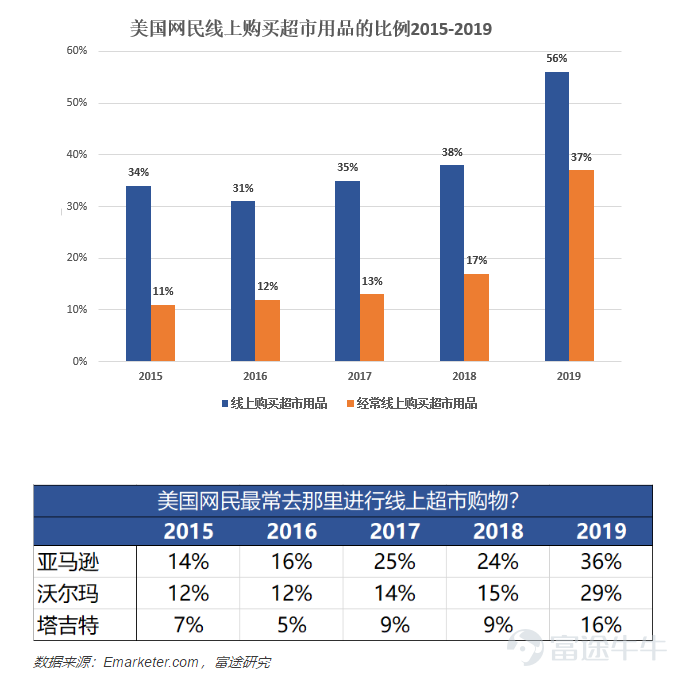
However, online retail may be a breakthrough point for Wal-Mart to attack e-commerce, but it is not enough, because online retail mainly includes goods with low profit and high cost in life. It can be predicted that in addition to the acquisition of jet.com, Wal-Mart has greater ambitions in the US e-commerce market. With November 11, 2019, Amazon announced that it will create a new offline retail supermarket and accelerate the improvement of the logistics network belonging to Amazon. The clarion call for the omni-channel retail battle in the United States has just sounded.
China Market: Nirvana Rebirth
China has the world’s largest e-commerce market, with e-commerce sales reaching US $ 1,943.078 billion, a growth rate of27.30%, accounting for 54.70% of the global e-commerce market share. The second-largest US e-commerce market is only $ 586.92 billion, less than a third of China’s, and the growth rate is only half that of China’s, about 14.00%. The Chinese market is a sweet scent that keeps the world’s retail giants alive.
However, things are always unsatisfactory. Wal-Mart entered the Chinese market in 1996. At the time, Alibaba was not established. By implementing the “everyday parity” hypermarket strategy, it was successfully welcomed by the majority of Chinese people. Until the outbreak of the mobile Internet and e-commerce markets in 2012, Wal-Mart’s traditional store business suffered a huge blow. Hundreds of stores were closed between 2012 and 2019, and more than 60 in the last three years. The former CEO Duke said in remorse in 2012: “I always hope that Wal-Mart can continue to innovate. Although we have become a leader in many fields, I still don’t know why Wal-Mart can’t move faster. Especially in e-commerce. “
Competitor, Amazon, has planted a bigger follower in China, and its market share in China has fallen from 15.4% in 2008 to 0.6% in 2019. In 2019, the fifteenth year of entering China, Amazon officially announced that it will stop providing seller services to third-party sellers on Amazon China’s website on July 18.
The departure of veteran US rivals has given Wal-Mart China a lot of momentum. November 2019. Wal-Mart plans to open 500 new stores and Yuncang in the next 5-7 years, and expressed confidence in the Chinese market, and will continue to increase investment and development; in the next three years, it will upgrade and upgrade 200 existing stores and strengthen omni-channel digitalization Experience, highlighting the core culture of freshness, money saving and convenience. In addition, taking advantage of Dongfeng’s upgrade of member economy and consumption, Wal-Mart plans to open 40 Sam’s member stores by the end of 2020; under the formation of a new retail perspective, Wal-Mart combined with JD.com to build community-friendly choice stores, sending them at the “maximum 29 minutes” The banner of home delivery has become a new foothold in the transformation of Wal-Mart China. In Q3 of 2019, Wal-Mart China’s sales increased by 6.30%, a comparable increase of 3.70%, and total sales reached 2.718 billion US dollars. Wal-Mart China has 433 stores, including 399 Wal-Mart hypermarkets; 26 Sam’s member stores; and 8 community HP stores. According to the table below, Wal-Mart China only accounted for 9.32% of international revenue. Compared with the previous year, it has an upward trend. The average revenue of a single store also has a lot of room for improvement.
